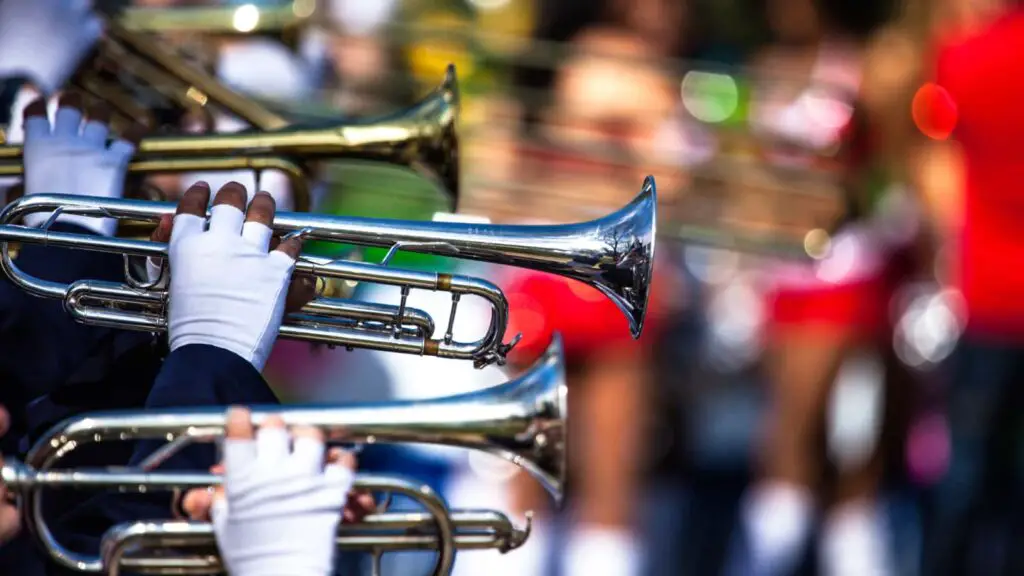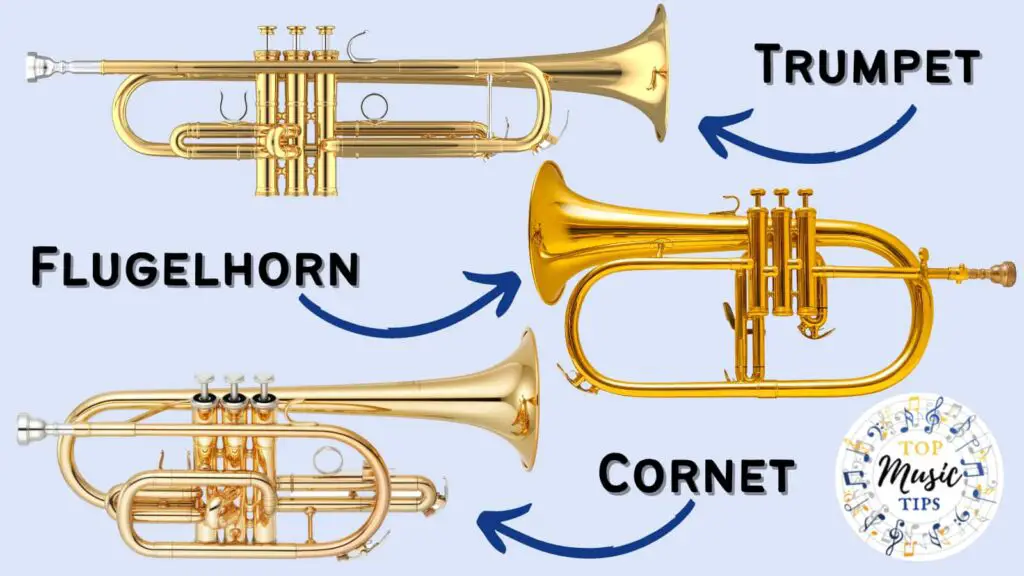Each musical instrument has a unique sound and shape that makes identifying them relatively easy. While a flute looks nothing like a tuba, some variations of instruments look alike.
Alto and tenor saxophones, Bb or Eb clarinets, baritone and euphoniums, trombones, and trigger trombones are some examples of this variation. This is a common occurrence in the brass section of the band.
One instrument with several variations is the trumpet. The trumpet is a popular instrument for beginner musicians, and most people can identify one by sight. This becomes more challenging when you add a flugelhorn (yes, they are real instruments) and a cornet to the mix. We have three different horns, but all look a lot like trumpets.

They look alike, but how can you tell them apart? This article will compare the three horns and discuss the differences between the flugelhorn, trumpet, and cornet. Keep reading for more about the flugelhorn, trumpet, and cornet!
Similarities Between Trumpet, Flugelhorn, & Cornet
Flugelhorns, trumpets, and cornets have many similarities in shape, construction, and playing techniques.
- They all belong to the brass family and are aerophones.
- They all require a musician to blow air through the instrument to produce sound.
- They are considered upper brass instruments.
- They can be found in brass and jazz bands across the globe.
- They all have their origins in military and hunting history.
- The flugelhorn, trumpet, and cornet share the same fingering patterns and basic techniques, which makes it easier to switch between all three instruments.
- All three of these brass instruments typically have three valves; although specialty four-valved horns do exist, three valves are seen and used more frequently.
- Like many brass instruments, the flugelhorn, trumpet, and cornet come in different pitches. However, for all three of these horns, a Bb horn is standard, and more of them are made and sold.
- Each instrument has a flared bell and uses a smaller-sized mouthpiece than other brass instruments like trombones or tubas.
The flugelhorn, trumpet, and cornet come in the standard plating of gold or silver. Don’t worry about holding the instruments or your embouchure differently. If you play the trumpet, you already know how to hold and play a flugelhorn and cornet. You can see how similar all three instruments appear below.

As you have learned, the flugelhorn, trumpet, and cornet have many similarities. Now it is time to learn about the differences between a flugelhorn, trumpet, and cornet. Let’s learn more about the unique features of each horn.
Differences Between Trumet, Cornet, and Flugelhorn
🎵 Bore Type
All wind instruments, including woodwinds and brass instruments, have a bore. The bore is the inner diameter of the instrument that your air travels through.
The flugelhorn, trumpet, and cornet have different bore shapes and sizes that change the instrument’s tone.
Note: Brass instruments are made with two main types of bores: conical and cylindrical.
A conical bore means that the diameter of the bore will gradually become wider throughout the instrument’s piping.
A cylindrical bore means that the diameter of the bore is consistent throughout the length of the tubing. The image below illustrates what both a conical and cylindrical bore horn looks like.
Brass instruments are a combination of these two main bore types, but the difference in bore combination separates flugelhorns, trumpets, and cornets from each other.
The flugelhorn has the highest combination of a conical bore than trumpets and cornets.
| Flugelhorn | 2/3 Conical | 1/3 Cylindrical |
| Trumpet | 1/3 Conical | 2/3 Cylindrical |
| Cornet | 1/2 Conical | 1/2 Cylinrdrical |
A flugelhorn is ⅔ conical and around ⅓ cylindrical. A trumpet is around ⅔ cylindrical and around ⅓ conical. Finally, the cornet is ½ cylindrical and ½ conical.
Note: Because the flugelhorn has the largest conical bore size, it has a much darker and mellow tone than the trumpet and the cornet.
🎵 Mouthpiece
The flugelhorn, trumpet, and cornet have differently shaped mouthpieces for each horn.
Unfortunately, these three instruments are not “one mouthpiece fits all” instruments. If you want to play one of these horns, you must rent or buy the proper mouthpiece.
The mouthpiece for a flugelhorn is a bit less conical than a standard french horn mouthpiece, and the shank is short and narrow.
Three of the best flugelhorn mouthpieces are:
- Bach Flugelhorn Mouthpiece Silver 1 ½ C,
- Yamaha YAC FH11F4 Standard Series 11F4 Flugelhorn Mouthpiece,
- Denis Wick DW 4884-4FL Gold-plated Flugelhorn Mouthpiece (which is said to produce a “classic British style tone”)
Trumpet mouthpieces are the only brass mouthpieces with a shallow bowl-shaped cup compared to the flugelhorn and cornet. Three of the best trumpet mouthpieces are:
- Yamaha YAC TR144A4A- HGPR Trumpet Mouthpiece
- Schilke Standard Series Trumpet Mouthpiece
- Bach 3C Trumpet Mouthpiece.
A cornet mouthpiece has a shorter and narrower shank than a trumpet mouthpiece because the cornet has a smaller receiver than the trumpet. The cup size is more profound than the cup for trumpets.
Some of the best cornet mouthpieces are:
- Denis Wick DW5881-4B Silver-Plated Cornet Mouthpiece
- Bach Cornet Mouthpiece Silver 3C
- Blessing Accordion Accessory MPC3CCR Cornet Mouthpiece.
🎵 Size and Weight
The flugelhorn, trumpet, and cornet are different sizes, and the weight of each instrument varies widely.
The flugelhorn is 19 inches long and is less tightly wrapped than the other two horns in this article.
Note: The larger size requires a musician to use more air to produce an excellent mellow sound on a flugelhorn than what is used for a trumpet. Switching from playing the trumpet to a flugelhorn will require a little experimentation with airflow, but the embouchure is the same as for the trumpet.
When it comes to weight, the flugelhorn is much heavier than trumpets or cornets. On average, a flugelhorn weighs between 9-11 pounds, which is heavier than a baritone or euphonium but still lighter than a tuba!
Like the flugelhorn, trumpets are usually 19 inches long, and the bell is the largest part of the instrument.
The trumpet is the instrument most people will learn to play before they try to switch to a flugelhorn or cornet since these two horns are far less commonly called for in concert bands and standard orchestra music.
In stark contrast to the flugelhorn, the trumpet weighs around 2.5 pounds. Trumpets are the lightest of the brass instruments.
The size of a cornet ranges between 13 and 16 inches long and is wrapped the tightest of all three. While the two instruments look similar and are made of the same length of tubing, a cornet is slightly lighter than a trumpet.
Typically cornets are around 2.4 pounds but can be lighter depending on the metal used by the manufacturer. The lightweight and compact design of a cornet make it a popular instrument for young beginner trumpet players because they are easier to hold correctly.
| Instrument | Length | Weight |
|---|---|---|
| Trumpet | 19 in. | 2.5 lbs |
| Cornet | 13-16 in. | 2.4 lbs |
| Flugelhorn | 19 in. | 9-11 lbs |
🎵 Prices*
While all instruments are expensive, the range of prices for the flugelhorn, trumpet, and cornet vary in their prices.
Flugelhorn Cost
A non-professional flugelhorn will cost between $1,359.00 and $3,500.00.
Three great flugelhorns are:
- King 650 Diplomat Series Bb Flugelhorn – $1,359.00
- Yamaha YFH6316 Series Bb Flugelhorn – $2,279.99
- Bach 183 Stradivarius Series Bb Flugelhorn – $3,499.00
Trumpet Cost
The price of a trumpet changes dramatically at each level, for example, a professional trumpet can cost around $6,000.
The lowest price for a brass trumpet is $269, and plastic trumpets are under $100. For a standard non-professional trumpet, these three are great options from well-known brands.
- Jupiter JTR700 Standard Series Student Bb Trumpet – $1,384.00,
- Yamaha YTR-2330 Standard Bb Trumpet – $1,499.00,
- Yamaha YTR-4335GII Intermediate Bb Trumpet – $1,699,99+.
Cornet Cost
Cornets are the most expensive instrument of the three. This is likely due to the instrument being produced in smaller quantities than trumpets, which makes the instrument more “uncommon.”
The price of a cornet ranges between $349.99 to $5,466.00.
Three great non-professional cornets are:
- Eastman ECN422 Series Bb Cornet – $1,282.00,
- Yamaha YCR-2310III Standard Bb Cornet – $1,499.00
- Bach 181SML Stradivarius Series Bb Cornet – $3,609.00.
* All prices were as listed on the Music & Arts website. Other instrument stores may charge more or less than the prices above.
🎵 Bands and Music
The flugelhorn, trumpet, and cornet are all brass instruments and are used in various bands, and there are famous pieces of music that were written to include each of these instruments.
Flugelhorns are a regular occurrence in British-style brass bands and jazz bands. They will appear in orchestras or concert bands, but it is not a standard instrument in either type of band.
Some famous music that features flugelhorns includes the musical Threni by Igor Stravinsky and Ralph Vaughan Williams’ Ninth Symphony. Often the flugelhorn is used instead of a posthorn in Gustav Mahler’s Third Symphony because it is often difficult to find an 18th and 19th-century posthorn in good playing condition since they are no longer commonly used or played.
The trumpet is the most widely used instrument of the three and can be found in concert bands, orchestras, and non-British style brass bands.
Since trumpets are pretty standard in these bands, much famous music was written that includes or features trumpets.
Pieces of music like Georges Bizet’s Carmen Suite No. 2, Johann Sebastian Bach’s Brandenburg Concerto No. 2 in F Major, and Gioachino Rossini’s William Tell Overture feature the trumpet. In the US, any concert music written or transcribed before 1960 will have separate parts for trumpets and cornets.
The cornet is used in British Brass Bands instead of trumpets. Typically nine Bb and at least one Eb cornet can be found in these brass bands.
Cornets are also featured in the British-style concert band, old swing-era jazz bands, and big bands. The symphony orchestra is the most common band to include a cornet because it can play a chromatic scale that trumpets cannot.
Note: Symphony orchestras also include trumpets, but the cornet serves to unify the sound of the french horns and trumpets.
Some famous music that features cornets includes Hector Berlioz’s Symphonie fantastique, Pyotr Tchaikovsky’s Capriccio Italien, and was initially used for the music to Igor Stravinsky’s ballet Petrushka. However, the cornets and the cornet solo from the first version of Petrushka in 1911 were removed by Stravinsky when he revised the score in 1946.
We hope this article has been helpful and informative for you in your musical journey. Please let us know if there is anything that we could add or change to make this article a better resource for our readers.
Please e-mail us at: [email protected] to let us know how we are doing!
Disclaimer: This post may contain affiliate links. We only recommend high-quality products that are used and recommended by real musicians. If you use these links to buy something we earn a small commission.
